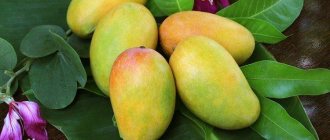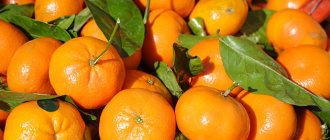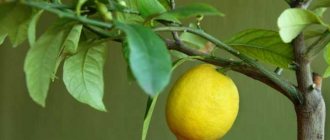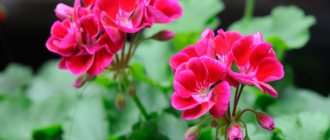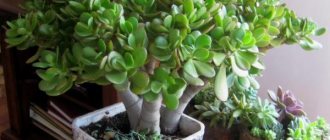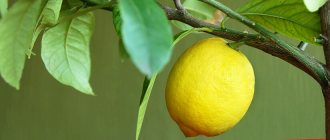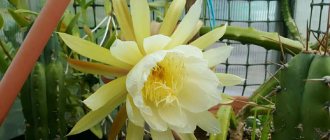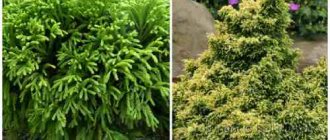- Mango tree at home: secrets of growing.
- Transplanting sprouted mango seeds.
- What does a seeded mango look like a couple of weeks after transplanting?
- Video and photos after a month: development of a mango tree.
- Caring for indoor mango.
Many of us are familiar with this tropical fruit. To date, of all the fruits that I have tried, mango, in my opinion, occupies a leading position. And since I eat it quite often, I have already learned to choose only ripe and sweet fruits. And so, once again, when I had a huge seed left in my hands, I suddenly wanted to try to germinate it and see what would come of it.
A ripe mango seed has a very high germination rate, about 70%. However, I’ll say right away that even if your mango grows well, you shouldn’t expect fruit from it - since only grafted specimens bloom and bear fruit. Therefore, if you want to achieve fruiting for your plant, then it is better for you to buy ready-made, grafted mango shoots, or to plant mangoes at home. If you, like me, are simply interested in the process itself, then you can continue reading this article.
To germinate a mango seed, you do not need any special skills or time. Everything is very simple, so this experiment can be done together with your child.
Mango in natural environment
In nature, mangoes can reach 30 meters in height.
In cramped apartment conditions, the plant, as a rule, does not grow higher than 2 meters. The mango has a spherical crown with elongated leathery leaves. The foliage is pinkish when young and turns dark green over time.
The flowers are small, white or pink, collected in inflorescences up to 40 cm long, the aroma is similar to that of lilies. Flowering from December to April. Fruiting begins at 5-6 years of plant life.
Types and varieties
There are two types of origin:
- Indian mango is distinguished by the bright red color of its young shoots, the juicy color of the regular shape of the fruit and its intolerance to moisture.
- Philippine or South Asian mango with light green growths and oblong fruits of the same color. They are more resistant to moisture and more resistant to climate change.
Each species has many varieties. According to some sources - about 500, according to others - about 1000. Varieties differ in the shade of inflorescences, size, shape, color and taste of the fruit. When grown on an industrial scale, dwarf varieties are preferred. They are also recommended for home breeding.
How it grows
For the mango tree, it is desirable to create conditions as close as possible to its homeland, heat and humidity. Then the plant will delight you with abundant greenery and flowering.
At home, it is very difficult to wait for fruits, since the conditions are often not suitable for the plant. Despite this, the tree actively grows, stopping growth during the dormant period.
Height
Mango grows very quickly. At home, the tree can reach 45 m. To keep the tree at the desired level, regular pruning and pinching is carried out. In a year, the plant can reach a height of more than 1 meter. When planting mangoes, it is necessary to provide sufficient space in the room.
Planting a seed
Which pot to choose for mango? You need to choose a small but deep pot. The roots of the plant will go deep into the soil, and a deep container will help avoid replanting in the near future. Plastic bottles with the neck cut off are also suitable for young plants.
At the bottom of the pot with a drainage hole, you need to place a 4-6 cm layer of pebbles or expanded clay to avoid rotting of the roots. The soil should be loose. You can buy it at a flower shop. It is better to use a succulent substrate or a universal soil mixture.
How to plant mangoes so as to wait for germination? It is important to bury the seed edge-on into the soil three-quarters of the way, leaving a small part on the surface. The side with the expected seedling should be in the soil.
For better germination of mangoes, you need to create greenhouse conditions. A simple and convenient solution is to use a plastic bottle. You need to cover the pot with the top half of a 2-liter plastic bottle. The lid sometimes needs to be opened and the “greenhouse” ventilated. Keep the soil moist, but do not flood it with water. It is better to place the pot in a place where it is warm and light. Germination should be expected after 20 days.
Is it possible to get mango fruits at home?
Mango looks great as an ornamental plant. But many gardeners sooner or later wonder how to get a harvest. In an apartment, mangoes begin to bloom, as a rule, by 5-6 years. But fruits appear only on grafted trees. To do this, you will need a branch of an already fruit-bearing tree. There must be at least 3 live gems.
Growing mangoes from seeds is easy. In most cases, the seed from a store-bought fruit germinates successfully. To bear fruit you need to be vaccinated. Mangoes cannot be planted outdoors and can only be grown as an indoor plant.
Choosing a mango fruit for planting
It is necessary to choose a ripe, or better yet, overripe mango. In an overripe fruit, the seed is often already open and has a sprout.
The ripe fruit emits a sweet, appetizing aroma. Soft when pressed. Overripe has a sour and alcoholic smell. If it is not possible to purchase ripe mango, then it can be brought to the desired condition within a few days. It is enough to wrap the fruits in paper and leave them at room temperature.
Growing mangoes indoors
The seed should be planted almost immediately after it is removed from the fruit. In this case, you should definitely choose a ripe mango. It is very easy to check whether the fruit is ripe enough. Thus, in a suitable mango, the pit can be separated from the pulp very easily. First rinse well and then use a sharp knife to remove the remaining pulp. After this, the prepared seed is carefully divided, thereby accelerating the germination process:
- If the bone breaks smoothly, you should remove the shell from it and carefully pull out the inside, like beans. Next, it should be treated with fungicides - agents that can resist the development of harmful fungi and spores. In the event that there is not one, but several embryos inside, it is necessary to choose only one of the greenest and smoothest, since its chances of germination are greater than those of the others.
- If it is very difficult to break the shell, no effort is required, otherwise the inside may be damaged. Mango seeds should be placed in a container that should be transparent, and water at room temperature should be poured into it. For the bone, choose the brightest place on the windowsill. This means it should lie there for several weeks. But do not forget to change the water every two days, otherwise it will turn sour.
So you need to choose a suitable vase. Due to the fact that a mango tree in nature can reach a height of 10-45 meters, the container for planting should be immediately large enough. In this case, by replanting the plant, thereby injuring the root system, you will lose less. Be sure to provide good drainage at the bottom of the container; for this, use special granules or small crushed stone. The drainage layer can prevent stagnation of liquid in the soil, and therefore the appearance of rot on the roots. For planting, you can use purchased universal soil, but keep in mind that it must be neutral in acidity.
To measure soil acidity, you can use a specially designed device called a soil pH meter or pH meter. It can also be replaced with disposable paper indicators. They change their color after contact with acidic soil (this happens within 1-15 minutes, and the time depends entirely on the indicator manufacturer).
There are two ways to plant:
- put it sideways - in case you don’t know exactly where the bottom is and where the top is;
- placement horizontally - if there is already a small escape.
The bone should not be completely covered with soil; a fourth of it should rise above the surface. After planting, fill the soil well and if it has settled enough, you will need to top it up a little to the required level.
To create the most suitable conditions for germination, you need to cover the top container with glass, cling film or ½ part of a plastic bottle. Do not forget to ventilate the mango; to do this, slightly lift the edges of the shelter every 2-3 days. This will help you avoid bone destruction.
A south-facing window sill is ideal for placing the pot, as the plant requires the most light. After 2-3 weeks, a sprout usually appears and the mango begins to grow. Next you need to remove the shelter from the container.
How to plant a seed correctly
To grow a tree indoors, you need to choose a ripe mango, preferably an overripe fruit, in which the seed may burst and the sprout will break. You should cut the fruit lengthwise, turning the halves of the fruit in opposite directions to release the pit. Then rinse the seed with water and slowly plant it in a 9 cm pot (humus with grass). You can make a greenhouse on top (for example, from a bag).
Advice! If the bone is intact, experts recommend soaking it for 2-3 days in a solution of potassium permanganate or water and waiting until it germinates. You can open the bone and take out the contents - the embryo is shaped like a bean. This way it will germinate faster. Fruit seeds cannot be stored for a long time; the quality of the seedlings deteriorates sharply.
At an average temperature of about +23 degrees, seedlings will appear in 3-4 weeks. The bush will need to be replanted annually into a larger container; the soil composition is the same. After 3-5 years, when replanting, small pebbles or a mixture of coarse sand (river) should be placed on the bottom.
Choose a sunny place; if there is a battery, you will need frequent spraying with warm water. Suitable fertilizers are needed for palm trees and oleander bushes.
A bush grown from a mango seed can be given different shapes - a ball, a pyramid or a cube. He will delight you with flowers only in a few years. You can see different varieties of mangoes in our photo gallery or on the Internet.
Seasonal calendar
Flowering of indoor mango begins in December and continues until April. In our country, this period begins with the arrival of spring. The fruit itself takes up to 6 months to form and mature. In Russia, the dormant period for mangoes is winter. At this time, it is necessary to slightly reduce watering the plant, do not forget to spray, and in winter this should be done with warm water.
In the spring, with the onset of flowering, it is necessary to start feeding the plant and continue throughout the summer until the plant forms fruits. After the harvest has ripened, fertilizing should be reduced, and with the onset of winter completely eliminated.
Where to get planting material
Mango is propagated by cuttings and seeds. Seedlings of this tropical plant are not cheap in nurseries. It is much easier to try growing it yourself from seeds. To do this, just buy a mango at your nearest store.
When choosing, you should give preference to fruits with elastic skin, without signs of damage or shock. The pulp of a suitable fruit is slightly crushed when pressed and is quickly restored. Mango should have a fruity aroma without impurities.
If you can't find ripe fruit in the store, you can try ripening it at home. To do this, wrap it in newspaper and place it in a dark place. As a rule, ripening occurs on days 5-6. You can speed up the process by placing an apple or banana next to the mango.
Requirements for containers and soil
When choosing a container for planting, it is necessary to take into account the following characteristics: the plant has a fundamental, rather long root system, so it is necessary to immediately prepare a tall and spacious pot, especially since it is not worth replanting a young seedling often. It won’t even work out too big: the roots in it can rot due to insufficient ventilation through the soil. The pot should have drainage holes (plastic ones usually have traces of holes that need to be poked with a hot knife or nail) and a tray.
Mango loves loose, fertile soil
For planting, you can buy ready-made soil with a neutral alkaline reaction, or you can mix garden soil with peat, sand and vermiculite (perlite) yourself to increase looseness, water permeability and breathability.
Before filling the pot with earthen mixture, do not forget about the obligatory drainage layer, which is made from expanded clay, small pebbles and broken bricks 5 cm high.
Preparing for landing
The easiest way to plant a mango is to bury the seed in the ground and wait for the sprouts to appear. This method has a serious drawback. Remaining pulp on the seed can cause rotting, and the seed simply will not germinate. Whatever happens, preliminary preparation of planting material should be carried out.
The shell of the mango seed is quite dense. It must be carefully opened with a sharp knife. The extracted core is immersed in a weak solution of potassium permanganate for 12 hours. After processing, the seeds are lightly dipped into a container with slightly damp sawdust. The future plant is placed in a warm, dark place, checking the moisture content of the sawdust from time to time. After 2-3 weeks, when shoots appear, you can transplant the plant into the ground.
The extracted bone should not be dried. The longer it is left outdoors, the less likely it is to germinate.
Choosing material for planting
As already mentioned, to grow mango at home, we need a seed of this fruit. For this purpose, you need to find the most mature specimen. If the fruit is unripe, then you may not wait for the sprout to appear. The ripeness of a mango should be determined not by color, but by density and smell. Ripe specimens will be softer and more aromatic.
Extracting the mango seed
The seed removed from the mango must be cleaned of any remaining pulp and outer shell, which has a shaggy surface, otherwise it may rot. In a ripe fruit, the pulp separates much more easily and easily.
Often a mango seed cracks inside, and a sprout begins to emerge from it. If the fruit is not ripe enough, then naturally this does not happen. Then you need to place the seed in a small container with water, or wrap it in damp toilet paper or gauze, and wait until it swells and puts out roots.
Mango seed sprouted in damp toilet paper
Before planting, it is good to treat the seed with some pre-planting solution and stimulant. This will protect it from pests and possible diseases, as well as give additional strength and increase germination.
Keep in mind that it is advisable to plant the seed immediately after removal from the fruit and pre-planting treatment. If you do not have this opportunity, then you can store it for about a day in damp sawdust, or wrapped in a damp cloth. You should not wait any longer; the seed will lose its viability and die.
Landing rules
The hatched seeds are planted in a container with soil, leaving 1/4 of the seeds above the surface. The seedling is lightly sprinkled with soil and watered abundantly with warm, stable water.
The pot is covered with foil, a glass or plastic bottle and placed in a warm, bright place. Once every 2-3 days, the seedlings need to be ventilated for 5-10 minutes. After the first true leaves appear, the aeration time begins to gradually increase, thereby hardening the plant.
Transplanting sprouted mango seeds.
The transplant was carried out as follows:
- Carefully took the sprout out of the pot and knocked off the excess soil from the roots. It was very interesting to look at this sprout; it stood on the roots like a figurine, and in general it looked like an alien creature.
- I added some coarse expanded clay to the bottom of the pot for drainage, sprinkled it with a mixture of earth and sand (3:1) and placed the “figurine” there.
- I sprinkled it with earth on all sides, not deepening the bone itself too much, about 1/3.
- Covered it with a cut bottle to create a greenhouse. Sometimes I unscrewed the cap of the bottle to air it out. You don’t have to make a greenhouse, so as not to adapt the sprout later to the unfavorable factors of the room or street.
The upper leaves still withered, but the side leaves began to grow very actively. In any case, this is all very funny, so I will grow a mango tree as long as it is able to stay indoors.
Plant care
Further cultivation of seedlings is not particularly difficult. The main thing is to provide:
- sunny location - south window sill;
- regular watering - 1-2 times a week with stabilized water at room temperature;
- daily foliar spraying.
- This treatment is recommended for all non-hairy indoor plants from the tropics.
Mango likes to water it with water from a spray bottle and shower head, wipe the leaves with a damp cloth, in the summer outdoors on the balcony or terrace.
Feed the tree with a universal complex fertilizer for indoor plants when watering.
In winter, a period of rest is not required, but additional lighting with a phytolamp is welcome.
To form a crown at the 8-leaf stage, it is necessary to pinch the tip of the shoot.
Annual spring pruning is carried out when the plant reaches one and a half meters in height.
For the first three years, the tree is replanted once a season, collecting a pot or tub of the required (larger) size, then it is replenished once every three years.
Features of care after purchase
After purchasing, the mango seedling needs to be replanted. The container for the tree should be large and spacious. The plant is installed on a lighter windowsill, it is better if it is located on the south side. Comfortable temperature is maintained at a minimum of 20 ° C, a minimum of 18 ° C.
In a pot, you must keep the soil moist and regularly spray the plant; mangoes love hot and humid climates.
Soil and pot
The pot for the mango tree should be spacious, because the well-developed root system of the plant requires space. Often a tropical plant should not be replanted - it does not like it.
The bottom of the pot is covered with drainage, small pebbles or expanded clay, up to 6-7 cm high. Drainage will not allow moisture to stagnate, which means it will protect the roots of the mango tree from rotting and it will provide them with oxygen.
The soil for mangoes is chosen to be light and neutral in acidity. Land can be purchased. If it is a universal soil, then sand is mixed into it in a ratio of two to one. For succulents, soil is suitable, to which small pebbles are added.
It is not difficult to prepare the soil for your plant yourself. Mixed peat - 1 part, fertile soil - 2 parts, coarse river sand or coconut fiber - 1 part. The container is filled two-thirds with earth, then moistened.
Temperature
It is best to place a container with a mature and grown shoot on the sunny side of the apartment. The light falling on the plants should be diffused. It is important to avoid direct sunlight as this can cause sunburn.
The best time to plant mangoes is late spring. In summer, the plant will receive enough heat and light and will be able to grow stronger. In winter, the sprout must be illuminated with a phytolamp. Daytime must be at least 14 hours.
The optimal ambient temperature is considered to be 24-27 ° C. In the warm season, the plant can be taken outside or to the balcony, placing the pot away from drafts.
Light
Mango is a light-loving plant. It is best to place it on a windowsill with good lighting. The main thing is that there is enough light. Additional sources of light and heat can be used to create a favorable habitat for the plant. I did this and ended up with great results.
Although growing mangoes indoors requires plenty of light, it is important to protect the fertile plant from direct sunlight. Direct rays during the day can burn the leaves. This can be avoided by using a small case. You can remove the tree completely, but the main thing is that no shadow falls on it.
Air humidity and watering mangoes
The mango tree not only needs warmth, but also the right humidity. Its level cannot be less than 70%. To maintain the required percentage in the household space, special air humidifiers are used and pots of water are placed.
Dry topsoil indicates that the mango tree needs watering. Usually two waterings per week are enough, more on hot days. The water for the indoor plant is predetermined and heated to room temperature. Too wet soil can cause rotting of the roots and trunk of the mango tree.
You can prevent moisture evaporation by mulching the soil with rotten wood shavings, sawdust, or well-rotted humus.
It is best to avoid spraying your home-grown mango tree, or do it infrequently and carefully, as this may cause mold growth. It is better to wipe the leaves of the plant with a damp cloth.
Top dressing
Feed mangoes every 2 - 3 weeks. Organic matter, nitrogen-containing preparations and vermicompost are replaced as fertilizers (vermicompost can be replaced with potassium humate or Epin solution). Mango grows well on ready-made citrus and palm complexes.
As a source of nitrogen you can use:
- 2-urea solution;
- ammonium nitrate;
- ammonium sulfate.
Organic fertilizer can be prepared at home. To do this, pour finely chopped nettles into a five-liter plastic container and add a handful of manure. The container is filled with water and left in a warm place for 5-7 days. The solution will be ready when the fermentation process has been significantly reduced. Before use, the solution is diluted with water in a ratio of 1:10. Such feeding is carried out in the summer.
Twice a year the plant is fed with humus. A groove is made in the ground along the edge of the container and filled with fertilizer. Sprinkle soil on top and lightly moisten.
Once every 3 months, mango leaves are sprayed with a solution of copper sulfate or boric acid.
Transfer
Mangoes are difficult to transplant. This causes stress to the plant, which may cause it to lose its leaves.
It is recommended to change the container no earlier than after a year, as the tree grows and gets stronger. Transplantation is carried out using the transshipment method. To do this, water the plant abundantly and leave for half an hour to soften the soil.
A drainage pad is placed in the new pot and lightly sprinkled with soil. The container with the plant is carefully turned upside down and the tree is removed along with the soil. Transplant into a new container and fill the voids with soil. The soil is well moistened. During the adaptation period, the tree is placed in a shaded place.
Formation
The plant responds well to formative pruning and actively restores the canopy. Training is carried out 1-2 times a year to adjust the size of the plant and maintain a beautiful shape. The procedure is carried out when the tree reaches 1.5 meters in height.
During pruning, all branches that thicken the crown are cut off. The central branch is shortened to the required length. The crown can be shaped in the form of a ball, a pyramid, or an enlarged bush. The pruning areas are treated with garden paint.
Every spring, the top of the plant is pinched to make the foliage fuller.
How to properly care for fruit
Caring for mangoes involves creating suitable lighting conditions, air humidity, watering, and fertilizing.
The seedling grows better with sufficient lighting. It is preferable to place the pot on a sunny windowsill. In summer, the seedling can be taken out into the open air. In winter, it is necessary to organize additional lighting with LED lamps or fluorescent lamps. With a lack of lighting, the plant stretches out and becomes weak.
The mango plant is moisture-loving and does not tolerate dry soil and air. With a lack of moisture, the leaves of the tree droop down and have a drooping appearance. The humidity in the room should be maintained at 70-80%. Mango does not tolerate drafts well. In the summer season, the plant is systematically moistened by spraying with settled water at room temperature.
You should not over-water the plant - fungal diseases and mold may appear. Excessive humidity causes intensive shoot development and reduces fruiting in mature mangoes. In winter, the plant is not sprayed. Water the plant without allowing the top soil layer to dry out completely. Excessive watering will lead to waterlogged soil.
The tree is fed once every two weeks in the spring. Suitable soil fertilizers are mineral and organic mixtures. Fertilizer for palm trees, vermicompost, and nitrogen-containing compounds used for growing persimmons or citrus fruits are suitable.
This stimulates the growth of green crowns. Microfertilizers are added once a year. Two or three times a summer, foliage is sprayed using a solution of boric acid, zinc sulfide and copper sulfate (1-2 g per liter of water). Excessive amounts of fertilizer will lead to salinity in the soil, which will inhibit tree growth.
Mandatory transplant methods
The first transplant is performed after a year. During this time, the seedling will strengthen the root system, grow and become stronger. For 5 years, transplantation is carried out annually. Subsequently, once every 3-4 years. The tree is replanted in the spring season or early summer. Each new pot is larger than the previous one. It is difficult to replant a large tree due to its size and weight. In this case, remove a few centimeters of soil from above and replace it with fresh one.
It is not recommended to transplant the plant immediately into a large container. The last transplant is carried out in a large pot or tub made of natural material - wood or ceramics. The pot should have a thick, wide bottom for stability so that the powerful root system does not grow through the bottom of the pot and damage the floor covering. You need to put a saucer under the pot.
Each transplant is stressful for the plant. The transplant process is simple, but requires care. Mango First, fill the soil in the pot with water for half an hour so as not to damage the root system. Drainage is placed in a new pot, soil is poured into a third of the container.
The plant is transferred to the prepared pot, carefully without shaking off the old soil, and placed in a new one. The top of the tree's root system should be level with the soil surface. The soil is not pressed down tightly; mango grows well in loose soil. The plant is watered and left in a shaded place for a week.
How mango blooms and ensures fruiting
A tropical plant grown at home from a seed will remain an evergreen decorative element of the interior. To achieve flowering and fruiting of mango, it must be grafted. The tree blooms for three to four months, then juicy and fragrant fruits appear instead of flowers. The home environment does not always allow you to fully experience the aroma of tropical fruits. But patient flower growers are guaranteed real exotic beauty and the aroma of the tropics.
What and how to prune a mango
Before pruning, select two leaves to see how the healing process proceeds. The weakest defective leaves on the branch are selected. Determine the position of the cut in the center, leave 5 mm of the leaf on the handle. After some time, the cut will dry out and break on its own. The tree tolerates pruning well, and the crown structure improves.
You can create a wreath in any style for the interior of the house at the discretion of the owner. Young trees should be pruned as they grow. Pruning of mature trees is carried out after fruiting, when the load on the tree is minimal.
The tree grows about a meter in height, pinching shoots of growth. The rapid growth of crown branches begins - 5-6 main skeletal branches located at a significant angle from the trunk. The branches of the area and part of the upper shoots are cut off, since with good care the tree quickly recovers. The crown is adjusted to the desired shape several times a year.
In the first two years, when fruit ovaries appear on the tree, they need to be thinned out. In subsequent years, thinning will be unnecessary. Mango fruits are large and have significant weight, so extra branches will simply crack under the weight. All weak, lateral, low and intersecting branches are removed so as not to restrict the growth of large mangoes.
Is it possible to pinch
It is necessary to pinch the mango regularly, otherwise the tropical owner will stretch out greatly and no longer fit into the room. Wounds should be covered with garden paint. Pinching will help make the tree crown more luxuriant and dense.
Mango grafting
For this procedure you will need a sharp, sterile knife. They need to carefully cut the bud with wood and bark. On the grafted tree, you need to make a not very wide cut, reminiscent of the letter T. Then carefully tear off the edges of the bark and insert the cut bud. The cut should be carefully wrapped with soft tape and can be removed once the bud has grown.
The first flowering after grafting usually occurs after a couple of years. After 100 days (3 months) from the moment the flowers appear, you can enjoy the juicy, aromatic fruits. The grafted tree needs systematic feeding (watering should be carried out only with nitrogen-containing fertilizers and mixtures). Mangoes especially need fertilizer during flowering and ripening.
Such a beautiful tree can become a real decoration of any room, but only with proper care and creation of the necessary conditions. And in order to get sweet fruits, the plant will need to be grafted and then systematically fertilized.
Types of mango
There are more than a dozen different types of mangoes grown in the natural environment. On store shelves you can most often find:
- Pink-orange mango. The fruits of this fruit have a narrow oblong shape. A distinctive feature is the thin peel of a delicate pink-orange color. Mangoes have dense flesh with a distinct sweet flavor. The weight of the fruit does not exceed 250 g.
- Pink-green. This variety is considered the best representative of mango. Many people do not pay attention to the fruits of this fruit, considering them unripe. However, the pulp inside has a rich orange color and a bright taste and aroma. The shape of the fruit is more rounded, and the average weight is 300-400 g.
- Green small mango. The fruits of this fruit have a bright greenish-yellow skin. And although this variety has the smallest fruit size, it is considered the sweetest and most delicious mango. The weight of the fruit is also small: it does not exceed 200 g.
- Dark green. A distinctive feature of this variety is the change in color of the peel: the riper the fruit, the darker it becomes. Mango pulp has a rich orange color and is also extremely soft. Because of this feature, fruits wrinkle easily and quickly disappear. The weight of the fetus ranges from 200 to 500 g.
- Classic yellow. This variety is considered the most famous. He is called the “noble” representative of the mango. The fruit has an elongated round shape, and its size varies from small to very large, reaching 0.5 kg. The ripe fruit has a cloying, sweetish, slightly sugary taste. But if, when choosing, you give preference to a slightly unripe fruit, you can enjoy a pleasant sour taste.
Common mistakes when planting mangoes
Failure to follow planting rules may result in the plant not germinating or quickly dying. The most common mistakes:
- Doesn't fit. If you bury the entire bone, the shoot will not have enough strength to break through the thick layer of soil. There is also a high probability that the seeds will simply rot. If the seeds are left on the surface, the seedling will not have enough moisture and will not germinate.
- Irrigation with cold water. Mango, like all tropical plants, is very sensitive to temperature changes. Low water temperatures can cause hypothermia of the plant and, as a result, loss of foliage. In addition, improper watering can provoke the development of fungal diseases.
- The wrong pot is being used. The capacity corresponds to the size of the plant. A vessel that is too deep causes the development of the taproot to the detriment of the above-ground part. The sprout will wither and die. In a container that is too shallow, the root system will not be able to fully develop.
- Unsuitable environmental conditions. For the first 2-3 months, mangoes are grown in greenhouse conditions. This will protect it from changes in temperature and humidity. The greenhouse is removed gradually, after the sprout has become stronger and accustomed to environmental conditions.
Planting a seed and getting the first few shoots is half the battle. In order for the plant to be healthy and pleasant to look at, it is necessary to strictly follow the rules of caring for the seedling.
Preparing the pit
The pit must be freed from pulp as much as possible. Clean it with a knife from all sides. The seed has a strong shell. The question arises: how to plant a mango seed in such a way as to shorten the germination period? It is important to follow the following recommendations:
- do not allow the bone to dry out,
- remove the kernel from the seed,
- treat the seed with a fungicide,
- immediately place it in the soil.
First you need to remove the core from the seed. This is a white seed with a brown parchment skin that looks like a large bean.
If the pit is tightly closed or difficult to open, then it needs to be prepared. Place the seed in a jar of water or wrap it in a wet towel for several days. It is necessary to change the water in the tank daily.
The second method is to ensure that the towel remains damp. After a few days, remove the bone from the jar or towel. The doors can be easily opened by hand. Remove the seed. Before planting, it is useful to treat the seed with an antifungal agent. And immediately plant it in a pot of soil.
Dangerous pests and diseases
Spider mites pose a great danger to tropical trees. Their sign is the nascent web. The cause may be high temperature and insufficient humidity. In the warm season - thrips feeding on the sap of leaves. This can be seen by discoloration or discoloration of the leaves.
- Common Mango Diseases:
- powdery mildew - white coating on leaves;
- bacteriosis - spots on leaves;
- anthracnose
Dry air turns the tips of the leaves brown. And in the cold the flowers will simply fall off.
How to choose a ripe mango?
Selecting a ripe mango may seem difficult at first glance, as the fruit comes in a variety of colors. But there are main signs that indicate the ripeness of the fruit:
- Regardless of the variety, the shade of the skin should not be dull, but rich and bright.
- The elasticity of the peel. If you press on it with your finger, a mark should remain. If the fruit is overripe, the peel will tear easily, but an unripe, green fruit will not yield to pressure.
- Aroma. Ripe mango has a pleasant sweetish smell.
- Condition of the peel. The surface of the fruit should be smooth, without damage, spots, limp or flabby areas.
Photo of growing mango from seed
How to properly peel, cut and eat?
There is no single way to properly peel, cut and eat mangoes. But there are several options from which everyone can choose the most convenient for them.
To peel a mango, make 4 cuts on the peel along the entire length of the fruit, and then separate the skin and get a peeled fruit. They cut it, take out the seed and cut the flesh into slices, squares or half rings, and then put it on a plate and eat it with a fork, spoon or skewer.
Another method is slicing, which involves first cutting the mango into two equal parts using a knife. Afterwards, the pit is removed and several horizontal and vertical cuts are made on each half so that squares are obtained that fit tightly to the peel. The skin is turned inside out, the squares are cut with a knife and placed on a plate. You can eat mango cut in this way in any convenient way.
There is an option that is great for cutting juicy and ripe mangoes. This fruit is divided into 2 halves, the pit is removed and the pulp is scraped out with a spoon onto a plate.
What does a mango look like?
In nature, mango (Mangifera indica) is a powerful evergreen tree that grows up to 40 m in height. The crown is wide, spreading, 10–15 m in diameter. Its homeland is the tropics of Southeast Asia. It is especially common in India, Thailand, Vietnam, and Myanmar. Nowadays, extensive plantations exist in the southern states of the USA, Mexico, the Caribbean and Central America, and Australia. Humanity has been growing mangoes for over 4,000 years. In its homeland it is called “fruit of the gods”, “great fruit”, and also “Asian apple”. According to legend, mangoes are a wedding gift from the god Shiva to his future wife Sati.
In nature, a mango tree can grow up to 40 m in height
The mango tree grows quite quickly, but you have to wait 10–15 years for fruiting. But its productive period is 250–300 years.
Mango plantations exist in many countries with tropical climates
It is not possible to grow mangoes in open ground in Russia. The climate and weather conditions are radically different from what the plant is accustomed to. But amateur flower growers have successfully “domesticated” the crop and even manage to get a harvest in “captivity.” In such conditions, the height of the tree is usually limited to 1.5–2 m.
Mango tree can bear fruit for 300 years
Mango leaves are long and narrow, lancet-shaped. The front side is painted bright green and has a glossy shine. The reverse side is lighter and matte. Young leaves have a yellowish, pinkish or reddish tint. At first they look very sluggish, lifeless. Don’t be surprised, this is the norm for the plant, and not some kind of exotic disease. In their homeland they are called “shawl leaves,” hinting that they look like laundry hung out to dry.
Young mango leaves are colored in different shades of reddish-yellow and pinkish - this is the norm for the plant
The juice of the leaves is poisonous. It can cause allergies, cause a rash, and redness of the skin. Therefore, any mango pruning work should only be done with gloves. The place for the plant pot should be chosen so that it is out of the reach of children and pets.
Mango blooms in early spring. The inflorescences consist of many small yellowish, pinkish or pale red flowers and are shaped like a raceme or panicle. They are very long, up to 30–40 cm. Each has at least several hundred flowers, often the number reaches a thousand. They emit a pleasant aroma, a bit like the smell of lilies.
Mango blooms very profusely; one inflorescence can contain up to a thousand flowers.
Video: what a mango tree looks like
Description of fruits
It takes 4–6 months for the fruit to ripen. The appearance of the fruit depends on the variety. There are also small mangoes, slightly larger than a plum, and “record holders” weighing more than 2 kg. The average weight of the fruit is 200–400 g, length varies from 5 to 22 cm. The skin is colored in different colors - from greenish and lime to dark scarlet and reddish brown, including all shades of yellow. Combinations of all three colors are often found. The skin is dense, matte, smooth to the touch, covered with a waxy coating. For ripe fruits, when pressed, it moves, but does not penetrate deeply.
The appearance and size of mango fruit depends on the plant variety
The pulp is bright, saffron, very soft, juicy and sweet, the taste is somewhat reminiscent of a mixture of apricot, peach, pineapple and melon, with a spicy aroma in which notes of lemon and roses can be discerned. Each fruit contains one large seed, hard and ribbed to the touch.
Mango pulp is very juicy and incredibly tasty, has a unique aroma
“Natural” mango fruits do not smell very pleasant. The smell evokes associations with mold, rot, even rotten meat. Many people even develop allergies to this “aroma”. This is explained by the fact that in nature, mangoes are most often pollinated by bats. They spread its seeds. But fortunately, the vast majority of modern varieties bred by breeders are devoid of this unpleasant feature.
Beneficial properties of mango
Mango is not only very tasty, but also healthy. The fruits are valued for their high content of essential amino acids, fiber, unsaturated fatty acids, flavonoids, pectin, vitamins B, A, D and E, as well as for their low calorie content. 100 g contains only 66 kcal, so mango can pleasantly diversify any diet.
Even small mango trees grown at home can produce a bountiful harvest.
In folk medicine, especially in India, mango is used very widely. The fruits are used to improve immunity, to combat migraines and stress, to relieve nervous tension, and also as an antipyretic and anti-inflammatory agent. It is also believed that regular consumption of mangoes is an effective prevention of the development of tumors, including malignant ones. Previously, it was recommended to eat them in order to avoid contracting cholera and plague.
Mango leaf infusion has been scientifically proven to have antibacterial properties. It can be used instead of mouth rinses. It is also recommended to drink it for diabetes of any type to avoid retinal detachment and normalize blood pressure.
There are also contraindications. Mango should not be combined with alcohol or abused if you do not want to develop persistent stomach and intestinal upset. Those who are prone to allergic reactions should try the fruits carefully - skin rashes, redness and swelling of the lips are possible. It is recommended to cool the mango before serving. Thanks to this, the specific oiliness of the pulp, which not everyone likes, is softened.
Video: health benefits of mango
How to replant a mango?
After the mango tree has grown to about 1.5 m, it will need to be transplanted into a larger container, since by this time the root system occupies almost the entire volume of the pot. Replanting mangoes should be done in the spring, at a time when the roots are growing very intensively. The new container should be approximately 5 cm larger than the previous one. It is better to replant using the transshipment method. For the first three years, the plant is replanted annually, then once every two years, and only then the tree can be planted in a large tub.
Mango for diseases
You should remember the peculiarities of consuming mango for various diseases.
Allergy
Exotic fruit can cause allergies. This is a common occurrence that should be kept in mind by anyone planning to eat a mango. A symptom of the development of an allergic reaction will be the appearance of a skin rash, redness and itching, swelling, diarrhea or, conversely, constipation. People who have such a reaction to the fruit should avoid eating it, as well as using any cosmetic products containing mango.
Gastritis
It is important for people suffering from gastritis to remember the rules for eating mangoes. This fruit is allowed to be eaten during remission, but only in small quantities. This is important, since mango fruits can cause an exacerbation of the disease. During the period of acute inflammation, the fruit is strictly prohibited.
Diabetes
Patients with diabetes are strictly prohibited from eating mangoes. This exotic fruit contains a large amount of carbohydrates, which can worsen the course of the disease.
Constipation
One way to treat constipation is to eat mango. This is because the fruit contains a large amount of fiber, which can regulate intestinal motility. It can be eaten chopped or added to oatmeal or smoothies.
Oncology
It is believed that regular consumption of mangoes can prevent the development of many cancers. Men and women often add this fruit to their diet to prevent cancer of the reproductive system and breast.
Poisoning and diarrhea
Mangoes are known to cause poisoning or diarrhea. If you eat a stale product or combine mangoes with alcoholic drinks, the risk of digestive disorders increases several times. Mango itself has an irritating effect on the gastric mucosa, and alcohol further provokes the development of inflammatory processes. Symptoms of poisoning include nausea, vomiting, diarrhea, general weakness and lethargy.
If mango is not the cause of poisoning or diarrhea, it is still not worth eating for these diseases: the fruit can worsen the course of the disease.
Pancreatitis
With pancreatitis, as with other inflammatory diseases of the gastrointestinal tract, it is better to refrain from eating mangoes.
Gout
If you have gout, it is not recommended to eat mango. It is believed that this product can cause an exacerbation of the disease, so if you want to eat an exotic fruit, it is better to consult your doctor.
Psoriasis
For psoriasis, mango is not only allowed, it is often used to treat this disease due to the antioxidant properties of the fruit. It is recommended to eat mango fresh, make juices and smoothies from it, and also prepare skin masks that have a healing effect. Regular use of masks relieves skin manifestations of the disease.
Ulcer
If you have a peptic ulcer of the stomach or duodenum, you should refrain from eating mango, as it can provoke a worsening of the disease.
Those who cannot imagine their life without this fruit, but suffer from inflammatory diseases of the gastrointestinal tract, can eat dried mango. This fruit contains a small amount of sugar and substances that irritate the gastric mucosa, so a small amount of dried mango is safe.
How to propagate mangoes?
This evergreen tree can be propagated in two ways:
- By cuttings
. To do this, cut off the upper, non-lignified parts of the shoots about 10-15 cm long and root them in the sand. In this case, you can use stimulants to speed up root formation, which often occurs within a month. However, in this way you can only get a beautiful ornamental plant. - Vaccination
. In order to grow a fruit-bearing mango tree, it is necessary to graft it. First, a seed is sprouted from a seed, then a sprout of a mango tree is planted in the ground, and in the second year of life, the young plant is grafted in the manner described above. This way you can get a tree with a compact crown, which is especially important when growing it at home. After 1-2 years, the owner will already be enjoying delicious and healthy mangoes grown with his own hands.
Mango for weight loss
Those who want to lose weight are advised to include mangoes in their diet. Thanks to the fruit’s ability to activate metabolic processes, normalize cholesterol levels in the blood and maintain the body’s water balance, natural weight loss occurs. In addition, mango reduces appetite and helps burn calories quickly. And although the fruit has sweet pulp, its calorie content is not so high - only 75 kcal per 100 g.
Despite the variety of beneficial properties, mango cannot be called a magic remedy for weight loss, so sticking to strict diets with this fruit or eating only one mango is wrong. However, of course, it is a healthy product and promotes weight loss due to its positive effect on the body as a whole.
When losing weight, you can prepare salads with the addition of mango. Among healthy eating enthusiasts, a fruit salad made from mango, kiwi, banana, pineapple and lime juice is popular. A more nutritious salad would be a salad made with chicken breast, bell pepper, white onion, cucumber, mango and lime juice. Seafood lovers will enjoy a salad made with shrimp, avocado, mango, white pepper and arugula.
In addition to salads, you can saturate your body with useful substances by preparing a smoothie. A tasty option would be drinks made from mango, passion fruit, orange, milk and honey.
How to plant mango?
Many lovers of exotic plants will be interested in learning how to plant a mango seed. To grow homemade mango, you must follow certain rules. The peel of a mango that is taken for propagation should be smooth, without spots or other defects. If you select a fruit that is not quite ripe, but large and beautiful, then it can be placed in a dry, warm place for ripening. The ideal option would be to buy fruit in late spring or early summer, since during this period they are not treated with preservatives for further storage.
How to prepare a mango seed for planting?
To grow a mango tree from a seed, you must first prepare planting material:
- Remove the skin from the entire surface of the fruit, cut the mango lengthwise and carefully remove the seed.
- Carefully scrape off the remaining pulp from it, otherwise they will rot in the ground in the future.
- To speed up germination, you need to split the seed and remove the embryo, which looks like a large bean.
- If the shell is very hard, then you should not crack it so as not to damage the seed. It is better to put it in water and leave it for several weeks in a well-lit place.
Soil for mango
In order to figure out how to grow a mango tree at home, you need to know what kind of soil this plant needs. It needs loose soil of neutral acidity. It is best to choose a cactus mixture in the store, which is ideal for homemade mangoes. If such soil is too dense, you can mix it with perlite, adhering to the ratio: 2 parts soil to 1 part perlite.
The homemade mango tree will not grow in loamy soil. If it is not possible to purchase ready-made soil, you can make it yourself. To do this, mix perlite, peat and coconut substrate in equal proportions. Such a soil mixture must be checked for acidity, and only after that can it be used for planting.
Mango pot
Since the mango tree has a taproot system, based on this, it is necessary to choose a container for its cultivation. The pot for it must be very deep. For an adult plant, a tub would be an ideal option. However, during germination and the first 1-2 years, you can keep a small mango tree at home in a pot up to 20 cm deep or in a 5-liter bottle with the neck cut off. A third of the container should be filled with drainage: broken bricks or small crushed stone, and soil should be poured on top.
Mango planting rules
–
In the middle of the container with the prepared soil mixture, a depression is made into which the sprouted mango seed is placed and sprinkled with earth. If the stem shoot is too large, then it should not be buried. Planting a mango will be successful if the pot, to create a greenhouse effect, is covered on top with plastic film or a two-liter plastic bottle placed bottom up.
What products does it combine with?
Most often, mangoes are eaten fresh, but do not forget that this fruit makes very tasty dishes, because it goes well with many foods.
Mango goes well with chicken and seafood. There are many recipes in which these products are stewed or baked together. Alternatively, you can make mango sauce to serve with meat dishes.
All kinds of fruit or vegetable salads are also prepared with the addition of mango. This fruit harmonizes with avocado, pineapple, orange, coconut, lime, peaches and apples.
In sweet desserts, mango becomes an indispensable component. For example, mango cheesecake has an excellent taste, in which the fruit is perfectly combined with delicate buttercream. Dairy products also go well with mango, especially in milkshakes or ice cream.
